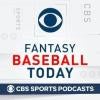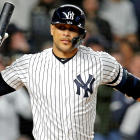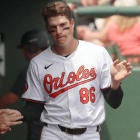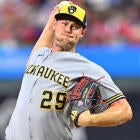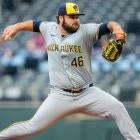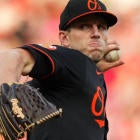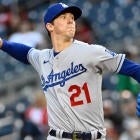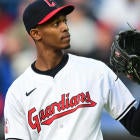It's always tricky, weighing the immediate payoff vs. the rest-of-season outlook, and the deeper you get into a season, the more the scales tip toward the immediate.
Everyone has their own sense of when is the right time to pull the plug on a player — mine is probably earlier than most professionals but later than the general public — and of course, the format makes a difference as well. You're more likely to do something reckless when you first starting playing, but once you get a feel for how long the season is, you learn not to overreact.
But what about when that season isn't as long?
If a shortened season does occur.... should we be quicker jettisoning a player who is under performing, as we won’t be able to wait for them to work it out?
— Shawn Johnson (@SSSPhillyBurb21) April 16, 2020
I had this same thought when I was rating every player's likelihood of being dropped within the first month. I was, of course, thinking in the context of a normal season, which we already know we're not going to have, which begs the question whether "one month" even means the same in a condensed season. Should it actually be more like two weeks?
What makes adjusting to the condensed schedule especially difficult is that it's not like players are going to streak and slump any differently. They're not going to bust out any quicker just because they know they have less time to do so, so what you're asking here is how much more reckless you can afford to be. And I would say only slightly.
It still mostly depends on your level of investment in the specific player. The earlier you draft him, the longer the leash he deserves. Your last few picks are players you can swap out whenever the mood strikes you, of course, but normally, we'd be halfway through a season before I considered dropping any of my first five picks, provided one hadn't suffered a long-term injury. And I might never be willing to drop my first- or second-round pick.
For players outside of that range, six weeks has roughly been my timeline for major shifts in opinion, and I don't think it's fair to change it. Looking back in particular at all the aces who struggled last April, I just think you risk giving up too much.
Why does anyone still participate in roto leagues?? It’s leagues for people who want to draft and then not actively manage. It’s a lazy mans format. Prove me wrong.
— D Z (@Dr__Spaceman_) April 16, 2020
Everyone's always hating on tradition. Tradition is good, all right? Familiarity brings comfort. It makes experiences more relatable across boundaries. If it's enough for you to look forward to it every year, it's enough.
Having said that ... Roto isn't my favorite format either. If I had to reduce my Fantasy Baseball leagues to just one, I can assure that the one would not be a Rotisserie league. Head-to-Head points leagues do a better job of approximating a player's real-life value, and Head-to-Head anything does a better job of keeping everyone engaged deeper into the season. Still, for variety's sake, it's fun to play the exact game played by Fantasy players of yore. And because it's a format everyone knows especially well, you can be sure no one has a familiarity advantage.
But I think what most Rotoheads would cite as the biggest perk for Rotisserie play is that it comes closer to rewarding the most deserving person. The one who wins is the rightful winner precisely because there are no playoffs that would allow for an upset scenario. So what you give up in interest level you get back in ... fairness, I guess?
I think your particular complaint doesn't hold water. Rotisserie participants make add/drops. They make trades and reconfigure their lineup every week, just like in any other format. In fact, I dare say the winner in your league last year probably turned at least one-third of his roster over — probably closer to half — which is why I think it's silly to suggest that leagues are won or lost on Draft Day.
No, my biggest complaint about Rotisserie is how it weighs all categories equally so that when one becomes scarcer than the others, as has happened with stolen bases, the players who contribute them become outrageously overpriced relative to their real-life worth. That leads into our next question ...
Tell me about Trea Turner in roto or categories. I don’t get it. When has he ever been deserving of that high of a draft pick?
— Mr. McLaughlin (@MrMcLaughlin4) April 16, 2020
I was calling it "stolen base derangement syndrome" back before I had done enough mock drafts to know better, but now I'm the most deranged of anybody, ranking Turner sixth overall in Rotisserie.
It's just that there are so few players capable of making a reasonable contribution in that category. The same is true for saves, of course, but there's sort of an unspoken agreement among Rotisserie players that the saves can stay on the board for a while. We'll distribute them once the stud players are gone. No such agreement exists for the base-stealers, though, which means you either have to buy in earlier than you're comfortable with or punt the category altogether. And it's such a volatile category, with such big swings in production from one year to the next, that you can never be totally sure you have enough.
It's why I'm surprised your gripe is with Turner as opposed to some of the base-stealers being pushed up draft boards. He's not only the single most reliable steals source but also a proven contributor in other areas. He'll of course score a bunch of runs, should help in batting average and won't set you back too far in home runs. With most of the other big base-stealers, you can't be sure what else you're getting, and if playing time becomes an issue as a result, the steals won't be there either.
An early investment in Turner spares you a headache later. It grants you the freedom to take the best player time and time again knowing you have a big advantage in the category everyone else is struggling to fill, sometimes stepping out of their comfort zone several times over to make it happen. As for whether or not he "deserves" it, it comes down to how much you hold his injury history against him. The one year he stayed healthy, 2018, he was the 11th-best hitter in this format, and he didn't run as much or hit as well as usual that year.
Who would you rather own in a dynasty league for next 5 years? Cole, Flaherty, or Gore?
— Kyle Belback (@Real_KyleBel23) April 16, 2020
If we're looking only five years down the road, yeah, I'll trust Gerrit Cole to remain a strikeout outlier through his age-34 season. It's not unreasonably old, and the chances of any of these pitchers losing a couple of the next five years to Tommy John surgery is already so high that I'd rather invest in the most proven commodity.
MacKenzie Gore is obviously out. He's about as high-end as pitching prospects get, but he's presumably going to spend some of those five years in the minors. And even when he does arrive, there will presumably be innings limits. It might be three years before we consider him a clear-cut Fantasy ace. Or it might — just playing the pessimist here — be never.
So really, it comes down to Cole and Jack Flaherty, and I'll admit my initial leaning was Flaherty, who won't even be 30 five years from now. But as big as Flaherty's breakout was in 2019, Cole still had nearly 100 more strikeouts. There are some fears Cole's ERA could rise as a fly-ball pitcher going to Yankee Stadium, but he isn't going to stop missing bats. Not everyone is so convinced Flaherty's breakthrough last year is all it appeared to be, and yet he's still playing catch-up to Cole.
Why are some players ADP so different between espn and other sites? Adalberto Mondesi, moncada, Guerrero, etc.
— Steve Mahaney (@Mahaney26) April 16, 2020
You're looking at the FantasyPros ADP page, aren't you? Yeah, the side-by-side comparison there can be pretty enlightening.
I can't speak to any one website's ADP results, but I can tell you that ADP results are largely a reflection of how the players are listed in the draft room. Just think of all the auto picks that are happening across all the leagues on those sites. Shoot, entire teams are being auto drafted. And anyone who shows up to a draft empty-handed is of course going to lean on the draft room for draft suggestions, mostly considering just the handful of names listed at the top. It's no surprise, then, that results would vary from website to website.
So what determines how the players are listed? Well, the default view in our draft room is SportsLine projections, though you can also sort by my rankings or Frank Stampfl's rankings. In that way, individual voices have a say. Small variations in format between the sites likely also has some influence.
Is Yordan all that?
— chris michaels (@chrismi39701392) April 16, 2020
Well, let me start by showing you the Head-to-Head point-per-game leaderboard among hitters with at least 300 at-bats last year:
1 | 4.71 | |
2 | 4.50 | |
3 | 4.30 | |
4 | 4.22 | |
5 | 4.21 | |
6 | 4.11 | |
7 | 4.04 | |
8 | 4.00 | |
9 | 3.96 | |
10 | 3.90 | |
11 | 3.90 | |
12 | 3.88 |
It's one thing to look at the raw stat line, which he didn't begin accumulating until June, but when you normalize playing time in this way, you get a better sense of the company Yordan Alvarez is keeping. As a 22-year-old seeing his first big-league action, he was as good as virtually any hitter.
Here's another eye-opening number: While he had 27 homers and 26 doubles during the four months he spent in the majors, he hit 50 homers and 42 doubles in all of 2019, majors and minors combined. Only three players in major-league history have reached those thresholds in a single season: Chris Davis in 2013, Albert Belle in 1995 and Babe Ruth in 1921.
The only remaining question, then, is how legitimate the performance was, and the more conspiracy-minded of us will scream something about trash cans. But it doesn't explain the Triple-A production. It doesn't explain Alvarez's .985 OPS on the road. It doesn't acknowledge the lack of evidence for any such cheating in 2019. Meanwile, Alvarez ranked in the 98th percentile for barrel rate, the 95th percentile for exit velocity, the 95th percentile for hard-hit rate, the 98th percentile for xSLG and the 98th percentile for xwOBA.
Yeah ... as long as his knee is fine, Alvarez is all that.
I want to hear fresh talk about late round pitchers! Nobody drafted:
— Ryan Donegan (@RyanDonegan2) April 16, 2020
Rich Hill
Jordan Montgomery
Garrett Richards
Nate Pearson
Nate Eovaldi
How many of these guys are worth a roster spot? Is there any upside here?
To be fair, I did address three of these pitchers in my deep sleepers article that came out right about the time our worlds were falling apart, but I can see how it might have gotten lost in the shuffle.
All right, let's address these five rapid-fire ...
- Rich Hill is probably the single player whose value has risen the most with the delayed start to the season, his elbow injury being originally projected to keep him out until June. At 40, he opted for a half measure rather than full-blown Tommy John surgery, so the risk of a setback is high. But over the past three years, he has a 3.30 ERA, 1.11 WHIP and 10.7 K/9. Particularly with the Twins lineup backing him, that's some serious upside.
- Jordan Montgomery, himself back from Tommy John surgery, was one of the biggest risers of spring training, striking out 16 with just one walk over 11 innings, and the curveball that made his 2017 rookie season such a success appeared to be in midseason form. Good supporting cast there, too.
- Garrett Richards made it back to the mound from his own Tommy John surgery late last season, confirming his recovery is behind him. In five seasons leading up to the surgery, he had a 3.15 ERA, 1.17 WHIP and 8.5 K/9, those numbers being bolstered by an elite ground-ball rate.
- Nate Pearson was the pitching prospect generating the most buzz this spring, allowing just two hits over seven innings with 11 strikeouts, including this beauty against Josh Bell. He threw only 101 2/3 innings in the minor leagues last year, but the condensed schedule increases his chances of making a significant big-league impact.
- Nathan Eovaldi showed promise with a new curveball over the final month last year — his first time introducing a true offspeed pitch to his power-laden arsenal — and it seemed to be working for him this spring with 12 strikeouts in eight scoreless innings.
I think all five of them deserve to be drafted in leagues 12 teams or deeper. Eovaldi's case seems the flimsiest to me, and Pearson of course has an uncertain timetable. Those are the two I would rank the lowest.
Seems like Stanton is a huge value in round 5 now in H2H points leagues. Guy could be #1 overall player. Why is he still going so late still
— JMS (@JMS23FF) April 16, 2020
Could he be the No. 1 player, though? I suppose during Giancarlo Stanton's MVP-winning 2017 season, an outlier for him in many ways, he was the No. 2 hitter in Head-to-Head points leagues. That's pretty close.
Of course, since then, his strikeout rate has reverted to where it's been for the majority of his career, making him only the 22nd-best hitter in this format the following year and the 40th-best on a per-game basis. And then there's the small matter of him coming off another year wrecked by injury, as has been typical throughout his career.
Stanton used to be more of a standout back before power hitting became so prevalent throughout baseball, but too many hitters have closed the gap. That one magical 2017 season when everything went right, including him staying healthy and demonstrating better contact skills than he ever had before, made it harder to see, but the follow-up performance in 2018 clarified how the typical Stanton season stacks up in today's environment. And especially given the likelihood of him missing time for one reason or another, it's not worth reaching for.
Round 5 is fine, but it's still asking a lot to go right. I'd prefer to take him a round or two later, actually.
So which sleepers should you snatch in your draft? And which undervalued first baseman can help you win a championship? Visit SportsLine now to get rankings for every single position, all from the model that called Kenta Maeda's huge breakout last season, and find out.








